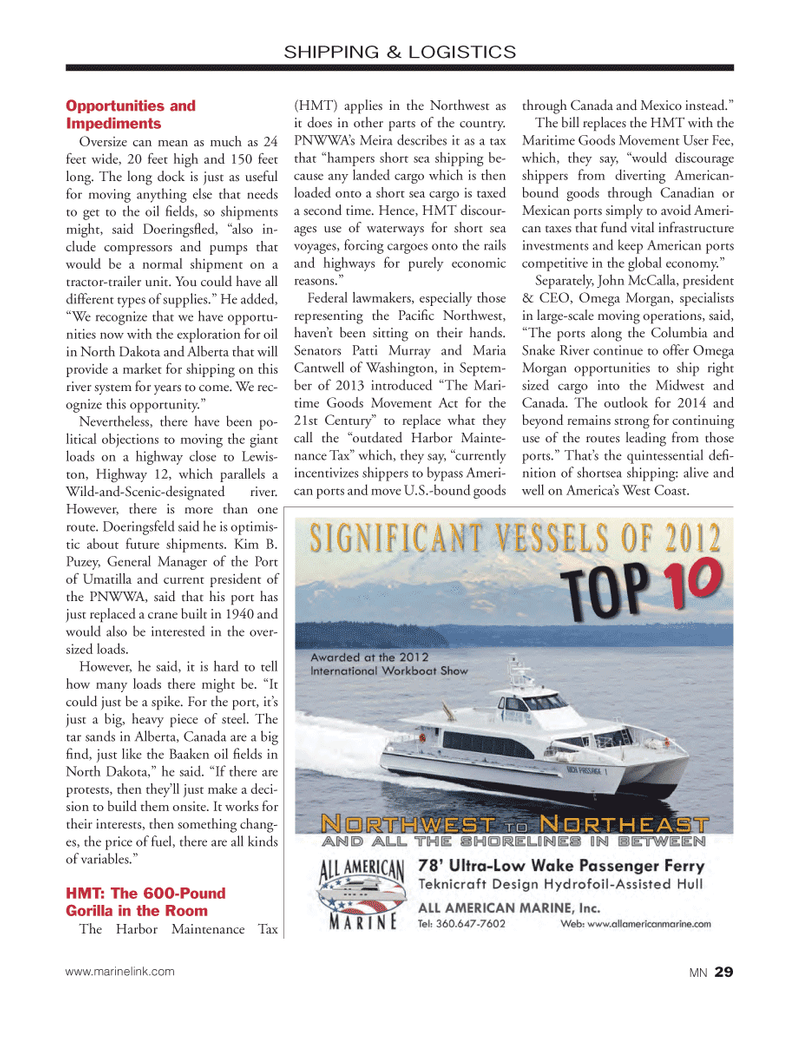
Page 29: of Marine News Magazine (March 2014)
Fleet & Vessel Optimization
Read this page in Pdf, Flash or Html5 edition of March 2014 Marine News Magazine
Opportunities and
Impediments
Oversize can mean as much as 24 feet wide, 20 feet high and 150 feet long. The long dock is just as useful for moving anything else that needs to get to the oil fi elds, so shipments might, said Doeringsfl ed, “also in- clude compressors and pumps that would be a normal shipment on a tractor-trailer unit. You could have all different types of supplies.” He added, “We recognize that we have opportu- nities now with the exploration for oil in North Dakota and Alberta that will provide a market for shipping on this river system for years to come. We rec- ognize this opportunity.”
Nevertheless, there have been po- litical objections to moving the giant loads on a highway close to Lewis- ton, Highway 12, which parallels a
Wild-and-Scenic-designated river.
However, there is more than one route. Doeringsfeld said he is optimis- tic about future shipments. Kim B.
Puzey, General Manager of the Port of Umatilla and current president of the PNWWA, said that his port has just replaced a crane built in 1940 and would also be interested in the over- sized loads.
However, he said, it is hard to tell how many loads there might be. “It could just be a spike. For the port, it’s just a big, heavy piece of steel. The tar sands in Alberta, Canada are a big fi nd, just like the Baaken oil fi elds in
North Dakota,” he said. “If there are protests, then they’ll just make a deci- sion to build them onsite. It works for their interests, then something chang- es, the price of fuel, there are all kinds of variables.”
HMT: The 600-Pound
Gorilla in the Room
The Harbor Maintenance Tax (HMT) applies in the Northwest as it does in other parts of the country.
PNWWA’s Meira describes it as a tax that “hampers short sea shipping be- cause any landed cargo which is then loaded onto a short sea cargo is taxed a second time. Hence, HMT discour- ages use of waterways for short sea voyages, forcing cargoes onto the rails and highways for purely economic reasons.”
Federal lawmakers, especially those representing the Pacifi c Northwest, haven’t been sitting on their hands.
Senators Patti Murray and Maria
Cantwell of Washington, in Septem- ber of 2013 introduced “The Mari- time Goods Movement Act for the 21st Century” to replace what they call the “outdated Harbor Mainte- nance Tax” which, they say, “currently incentivizes shippers to bypass Ameri- can ports and move U.S.-bound goods through Canada and Mexico instead.”
The bill replaces the HMT with the
Maritime Goods Movement User Fee, which, they say, “would discourage shippers from diverting American- bound goods through Canadian or
Mexican ports simply to avoid Ameri- can taxes that fund vital infrastructure investments and keep American ports competitive in the global economy.”
Separately, John McCalla, president & CEO, Omega Morgan, specialists in large-scale moving operations, said, “The ports along the Columbia and
Snake River continue to offer Omega
Morgan opportunities to ship right sized cargo into the Midwest and
Canada. The outlook for 2014 and beyond remains strong for continuing use of the routes leading from those ports.” That’s the quintessential defi - nition of shortsea shipping: alive and well on America’s West Coast.
SHIPPING & LOGISTICS www.marinelink.com MN 29
MN MAR14 Layout 18-31.indd 29 2/21/2014 3:23:23 PM

 28
28

 30
30
